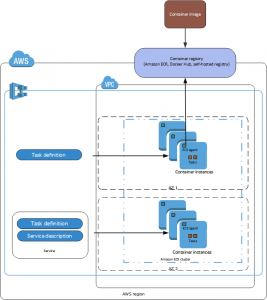Amazon Elastic Compute Cloud (EC2) forms a central part of Amazon.com’s cloud-computing platform, Amazon Web Services (AWS), by allowing users to rent virtual computers on which to run their own computer applications. EC2 encourages scalable deployment of applications by providing a web service through which a user can boot an Amazon Machine Image (AMI) to configure a virtual machine, which Amazon calls an “instance”, containing any software desired. A user can create, launch, and terminate server-instances as needed, paying by the hour for active servers – hence the term “elastic”. EC2 provides users with control over the geographical location of instances that allows for latency optimization and high levels of redundancy.
Amazon EC2 Container Service (Amazon ECS) is a highly scalable, fast, container management service that makes it easy to run, stop, and manage Docker containers on a cluster of Amazon Elastic Compute Cloud (Amazon EC2) instances. Amazon ECS lets you launch and stop container-based applications with simple API calls, allows you to get the state of your cluster from a centralized service, and gives you access to many familiar Amazon EC2 features.

You can use Amazon ECS to schedule the placement of containers across your cluster based on your resource needs, isolation policies, and availability requirements. Amazon ECS eliminates the need for you to operate your own cluster management and configuration management systems or worry about scaling your management infrastructure.
Amazon ECS can be used to create a consistent deployment and build experience, manage and scale batch and Extract-Transform-Load (ETL) workloads, and build sophisticated application architectures on a micro services model.
Amazon ECS is a regional service that simplifies running application containers in a highly available manner across multiple Availability Zones within a region. You can create Amazon ECS clusters within a new or existing VPC. After a cluster is up and running, you can define task definitions and services that specify which Docker container images to run across your clusters. Container images are stored in and pulled from container registries, which may exist within or outside of your AWS infrastructure.
To make EC2 more fault-tolerant, Amazon engineered Availability Zones that are designed to be insulated from failures in other availability zones. Availability zones do not share the same infrastructure. Applications running in more than one availability zone can achieve higher availability.

EC2 provides users with control over the geographical location of instances that allows for latency optimization and high levels of redundancy. For example, to minimize downtime, a user can set up server instances in multiple zones that are insulated from each other for most causes of failure such that one backs up the other.
Higher-availability database services, like Amazon Relational Database Service run separately from EC2 instances.
You can work with Amazon ECS in any of the following ways:
- AWS Management Console
- The console is a browser-based interface to manage Amazon ECS resources. For a tutorial that guides you through the console, see Getting Started with Amazon ECS.
- AWS command line tools
- You can use the AWS command line tools to issue commands at your system’s command line to perform Amazon ECS and AWS tasks; this can be faster and more convenient than using the console. The command line tools are also useful for building scripts that perform AWS tasks.
AWS provides two sets of command line tools: the AWS Command Line Interface (AWS CLI) and the AWS Tools for Windows PowerShell. For more information, see the AWS Command Line Interface User Guide and the AWS Tools for Windows PowerShell User Guide.
- Amazon ECS CLI
- In addition to using the AWS CLI to access Amazon ECS resources, you can use the Amazon ECS CLI, which provides high-level commands to simplify creating, updating, and monitoring clusters and tasks from a local development environment using Docker Compose. For more information, see Using the Amazon ECS Command Line Interface.
- AWS SDKs
- We also provide SDKs that enable you to access Amazon ECS from a variety of programming languages. The SDKs automatically take care of tasks such as:
- Cryptographically signing your service requests
- Retrying requests
- Handling error responses
The Above mentioned is a Brief about the Amazon Elastic Compute Cloud. Watch this space for more updates on the Latest Trends in Technology.
